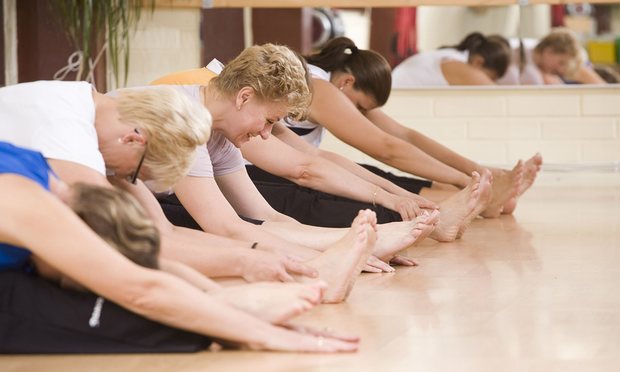Should yoga be part of NHS care?

Yoga is cheap, sociable and available in a number of forms to suit all ages, tastes and abilities. Photograph: Juha Tuomi/Rex
Some patients at The Docs city-centre surgery in Manchester emerge from the consulting room, minus a prescription, but clutching a voucher for a free yoga class courtesy of staff at the practice who are convinced that yoga deserves a more prominent part in NHS care.
The tickets entitling the bearers to a 45-minute class at the nearby Studio 25 were initiated by one of the partners, Dr Matthew Joslin. He developed them following powerful Facebook support for an open letter he wrote to the NHS in January appealing for greater incorporation of the Indian exercise and mindfulness techniques into day-to-day healthcare. The letter received 17,000 Facebook shares.
Astonished at the reaction, 46-year-old Joslin has added to his 16 years as a yoga practitioner by training to teach the physically-demanding Ashtanga form of the practice. He plans to start giving one class a week from June onwards at Studio 25, and later in the basement at The Docs when work has been carried out to convert it into a yoga studio, with a physiotherapist also on hand to tackle a range of musculoskeletal problems.
“It is time yoga became the default option to get people moving, improve strength, flexibility and posture and – while you’re at it – to bring a helping of mindfulness to promote mental health,” says Joslin.
This is not just about bad backs and dodgy knees. Joslin has become aware that many of the men and women coming into the consultation room of his inner-city practice bring problems that he feels yoga could help. Cardiovascular disease, diabetes, pregnancy, back pain, obesity, mental health issues, social isolation and a number of the difficulties faced by people in old age fall into this bracket.
Yoga is cheap, sociable and available in a number of forms to suit all ages, tastes and abilities – from the more static and strengthening Iyengar, the therapeutic and meditative Svastha, to the cardio workout offered by Ashtanga. Could it be a way of hitting a number of health problems at once?
‘It is time yoga became the default option to get people moving, improve strength, flexibility and posture,’ says Dr Matthew Joslin.
Figures from Sport England from 2013-14 suggest that 388,200 people over 16 participated in yoga for 30 minutes every week – up from 296,800 in 2008-09 – and the NHS England chief executive, Simon Stevens, announced last autumn that yoga was to be offered to health professionals alongside Zumba and health checks, in a package aiming to cut the £2.4bn annual cost of sick leave in the health service.
However, recently-issued draft guidelines on lower back pain from the National Institute for Health and Care Excellence (NICE) do not mention yoga specifically in recommendations that people take exercise to improve their condition. Although NICE says its recommendations do not exclude yoga, there is not enough scientific proof that it works.
Joslin started yoga to cure a bad back but became hooked by the practice when he was introduced to Ashtanga during a period of anxiety and depression that nearly made him quit medicine. He now goes to three classes a week, including a Friday lunchtime class accompanied by The Docs’ GP trainee, Shahnawaz Khan, and practice nurse, Wendy Cooke.
The 45-minute Yoga Express programme, to which he sends his patients, was devised by renowned yoga teacher Matt Ryan, who used to be a DJ at Manchester’s Hacienda nightclub, and used the practice as his way out of drug and mental health problems.
The GP reels off anecdotal examples of patients who have had similar positive experiences – an adult with neurological damage following meningitis, who now has better balance and coordination; a woman with serious depression, who communicated after her first session of yoga.
A major problem is that the evidence base for yoga is not there. A Cochrane review of yoga and back pain pointed this out, even though there is a strong support for the benefits of exercise on cardiovascular disease. Another difficulty about yoga is that it is used to describe a number of practices from the meditative to the highly athletic.
Dr James Newham, from Newcastle University’s Institute of Health and Society, and researchers from Manchester University have carried out the first study of antenatal yoga in the UK – published in the journal Anxiety and Depression – showing that a single session of yoga reduced self-reported anxiety by a third and stress hormone levels by 14%.
Dr Kishan Rees, a clinical teaching fellow in medical education at Lincoln UMED, believes that economic constraints on the NHS call for a broader view of public health. “There may be a lack of evidence to support some complementary therapies such as Yoga,” he says. “However, as long as it causes no harm, these approaches should be implemented as part of a toolkit people can access as they see fit.”
In the US, the work of the meditative aspects of the yoga by psychologist Dr Richard Miller have been officially recognised. He used the state of lucid sleep (yoga nidra) to treat post-traumatic stress in soldiers returning from Iraq and Afghanistan.
The government’s Mindful Nation project backed the concept of mindfulness and recommended that mindfulness-based cognitive therapy should be commissioned on the NHS for recurrent depression. In the UK, the Phoenix Prison Trust takes yoga and meditation to prisoners, to improve their physical and mental wellbeing.
Justin Varney, interim deputy director of health and wellbeing at Public Health England, says: “There are a variety of types of activity that people can undertake to contribute towards achieving a healthy amount of physical activity, with most people preferring to undertake a mix. Yoga is an excellent way to achieve the two sessions of muscle strengthening per week in alignment with our guidance.”
Joslin believes that austerity and the Facebook reaction suggest yoga is worthy of more careful official consideration. “I want to see whether there is a way to marry the amazing healing sustaining practice that is yoga, with the services offered by the NHS,” he says. “The NHS already sends people to the gym and to swimming pools. Find me a physiotherapist who doesn’t think yoga is a good idea.”
Source: http://www.theguardian.com/healthcare-network/2016/apr/26/should-yoga-be-part-of-nhs-care?CMP=ema-1700&CMP=







